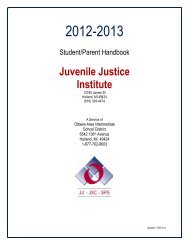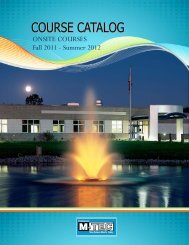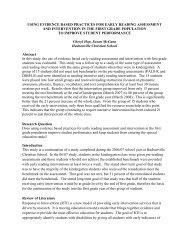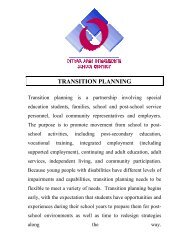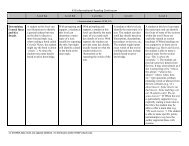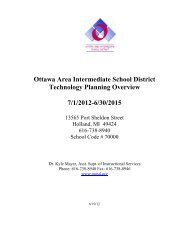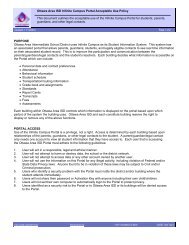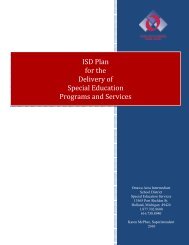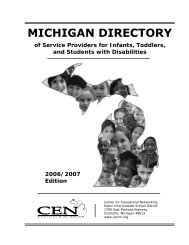Are DIBELS and Running Records effective tools for guiding ...
Are DIBELS and Running Records effective tools for guiding ...
Are DIBELS and Running Records effective tools for guiding ...
Create successful ePaper yourself
Turn your PDF publications into a flip-book with our unique Google optimized e-Paper software.
Table 1September 2007BGL GL AGLFirst Grade 80% 15% 5%Second Grade 95% 3% 2%Third Grade 75% 25% 0%Fourth Grade 79% 13% 8%Fifth Grade 67% 33% 0%As data collection examined the student achievement in all grades (1-5), students who enteredsecond grade during the 2007-2008 school year demonstrated a weaker grasp of storycomprehension, fluency, <strong>and</strong> decoding skills. The number of students at or above grade leveldecreased dramatically. Teachers were provided assistance from the reading interventionspecialists <strong>and</strong> received support from the LIFT program (Learning is Fun Together), by buildingself esteem <strong>and</strong> confidence under the direction of a mentor, one that faciliated a lesson pl<strong>and</strong>irected by the reading intervention specialist.Although notable gains are witnessed the collaborative grant team determined that the transitionfrom narrative to expository text hindered the achievement of learners on the assessment, as 43percent of all third grade students achieved benchmark in the <strong>DIBELS</strong> Oral Reading Fluency,while 29 percent were in the some risk category. Also noted is the number of studentsper<strong>for</strong>ming Below Grade Level on the Rigby <strong>Running</strong> Record Benchmark Assessments inSeptember. Anecdotal notes collected indicated students struggled with the retelling of theexpository literacy pieces, however, excelled in the final narratives provided. The transitionfrom story elements to main idea along with supporting details needed to recap the expositorypiece hindered learners from mastering the running record assessment. Thus providing a newfocus <strong>for</strong> the learning community <strong>for</strong> the 2008-2009 school year.The growth in third, fourth, <strong>and</strong> fifth grades illustrates continued practice with the retelling ofexpository pieces in language arts. In correlation to our <strong>DIBELS</strong> scores, where 58 percent of thestudents demonstrated proficiency in the oral reading fluency, students scored significantlyhigher in fourth grade at the end of the benchmark cycle in April. This two can be noted in thedata that 59 percent of all students passed the oral reading fluency portion of the <strong>DIBELS</strong>assessment in the fifth grade. The results of the <strong>DIBELS</strong> testing assist in predicting studentachievement on the running records assessment as well.Table two illustrates this progression <strong>and</strong> growth as the comparison of January <strong>and</strong> April scoresare noted across all grade levels. Especially important is the percentage of change between gradelevels, as a larger portion of students were at or above grade level on running records in gradesthree, four, <strong>and</strong> five.



